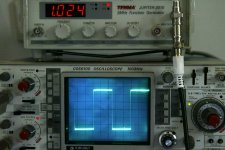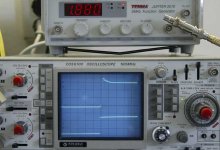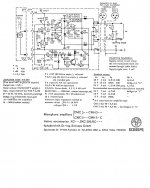.
Starting from an amplitude earlier as expected, the output of the amp started to produce a distorted square wave.
When replacing the ceramic NP0 cap by a silver mica cap, the problem was solved.
I mentioned at the same time that it was not at all my intention to disqualify NP0 caps, but it was a strange non expected experience.
Could be very well a parasitics effect. I recall snipping pin 1 and 5 of an opamp in SOIC, to lower the inverting input and output parasitic caps by 0.1pf and stop the oscillations. Was a video amplifier with 250MHz bandwidth and required linear phase.
Especially for you the second time. http://www.gyraf.dk/gy_pd/g7/gic_s.gifWhere? Most diaphragms are mylar.
As for the membranes, the first ones were made of PVC. Mylar was chosen as the membrane material because it is thinner, lighter and more resistant to tearing. Moreover, the membrane itself is not a capacitor, it is covered with gold and is a flexible composite electrode made of gold reinforced with mylar, which is one of the capacitor plates in the microphone capsule, see the diagram.
Last edited:
I wonder if the COG cap was cracked or damaged Hans.
Have to say that is a weird problem. I found, and read, that COG/NPO caps are exemplary. Not Teflon good but then they are a small fraction of the size.
Have to say that is a weird problem. I found, and read, that COG/NPO caps are exemplary. Not Teflon good but then they are a small fraction of the size.
I think they are called NP0, C0G not NPO or COG.
https://www.tme.eu/Document/a556da97341b52257167181ac42b746d/KEM_C1003_C0G_SMD.pdf
https://www.tme.eu/Document/a556da97341b52257167181ac42b746d/KEM_C1003_C0G_SMD.pdf
I wonder if the COG cap was cracked or damaged Hans.
Have to say that is a weird problem.
Both channels reacted the same, so I don't think a damaged cap was the case.
Going back 14 years in my archive, I saw that the square wave offered to the anti-Riaa had 1usec rise time, quite an unrealistic risetime to be fair.
Anyhow, I could hardly get 100mV undistorted from the output, translating for this case into a 2mV square wave from the output of the AD797, which had the complete Riaa network in its feedback.
At the input, spikes of almost 50mV 1usec wide had to be coped with.
Probably like Syn08 suggested, some parasitic effect like the Mica cap having a higher ESR made the bandwidth enhancement a bit less aggressive or whatever.
See scope pictures with undistorted 100mV output and with the distorted squarewave at 150mV out.
After having replaced the NP0 with Mica silver, 150mV was flawless.
But again, for a Riaa amp nothing to worry about because far outside a realistic range, but intriguing when comparing caps.
Hans
Attachments
For all the technical babble and naval gazing in this thread you guys miss out on the real technical advancements being made
Rockwell Retro Encabulator - YouTube
And there are teflon pf value caps now available so we don’t have to have the ceramic versus silver mica bun fight
https://www.cde.com/resources/catalogs/MCM-MIN.pdf
Rockwell Retro Encabulator - YouTube
And there are teflon pf value caps now available so we don’t have to have the ceramic versus silver mica bun fight
https://www.cde.com/resources/catalogs/MCM-MIN.pdf
Last edited:
they go up to a whooping 32 pF before they transition into using Silver Mica. Lower on higher voltages.
Didn't bother looking up price.
Cheers
Alan
Didn't bother looking up price.
Cheers
Alan
C0G and NP0 are not ‘ceramic’ dielectrics AFAIK.
I use them in a power amplifier for the main comp caps and get 7 ppm at 200 W into 8 Ohms. I suspect the real distortion levels are close to 1 ppm since most of the distortion is from the generator as confirmed by the generator supplier specs.
Let’s not fall into a C0G/NP0 are sub par rut . . . They are not.
I use them in a power amplifier for the main comp caps and get 7 ppm at 200 W into 8 Ohms. I suspect the real distortion levels are close to 1 ppm since most of the distortion is from the generator as confirmed by the generator supplier specs.
Let’s not fall into a C0G/NP0 are sub par rut . . . They are not.
Looks like I’ve been nailed again.
Let there however be no doubt that it makes a good cap!
C0G (NP0) Dielectric | AVX
😉
Let there however be no doubt that it makes a good cap!
C0G (NP0) Dielectric | AVX
😉
Last edited:
Especially for you the second time. http://www.gyraf.dk/gy_pd/g7/gic_s.gif
Gyraf is a DIY friendly business with the usual claims of dramatic improvement with capacitor upgrade (they aren't the only one). Most OEM mics from even the best manufactures use ceramic caps otherwise why would all the upgraders exist?
This mic is a DIY project not a product.
Last edited:
It uses a capsule CK12 from AKG , and the dielectric in this capacitor, as in other tube microphones from other manufacturers, is air, not mylar.
How would a capsule have anything other than air, what's your point? It's easy to make a microphone without the input coupling cap in the first place.
There is much that can be done, but today we see exactly what has already been done for us. These are capsules with air dielectric, and capacitors made of polystyrene.
https://pbs.twimg.com/media/DNEpm_pU8AExLs1?format=jpg&name=small
https://www.elektroakustika.cz/images/rft/mv/mv102/mv102_5.jpg
https://pbs.twimg.com/media/DNEpm_pU8AExLs1?format=jpg&name=small
https://www.elektroakustika.cz/images/rft/mv/mv102/mv102_5.jpg
Last edited:
How do I switch the radiation pattern in this scheme? There are many similar patterns on pipes too. However, the radiation pattern cannot be switched without a capacitor. The CK12 capsule allows three types of radiation patterns in one microphone. At the same time, Gyraf, AKG and similar microphones sound great with the right choice of condenser type. http://www.gyraf.dk/gy_pd/g7/gic_s.gif
Last edited:
You are off the original topic, if you have any real evidence that there is an audible difference between an NPO ceramic and PS cap in an application where there is virtually no AC voltage across the cap please present it.
No, you are not in the subject, but especially about tube microphones. I showed you this example because it is the most sensitive point in the signal path. And even their gold-plated polyester diaphragms in capsules are not polyester capacitors at all. Moreover, in the best models of tube microphones, capacitors are used, with a polystyrene dielectric.
Last edited:
The best cap is no cap, plenty of examples.
Very elegant circuit!
In that circuit the diaphragm is biased instead of the backplate. Downside is the need for additional screening/shielding. The measurement mikes use metal diaphragms so no plastics anywhere but a cap is necessary. FWIW the B&K 2619 uses a glass capacitor. I'm not sure those are still made. OK: https://www.mouser.com/datasheet/2/88/cy06-08-318696.pdf Still quite expensive.
- Home
- Member Areas
- The Lounge
- The Black Hole......


